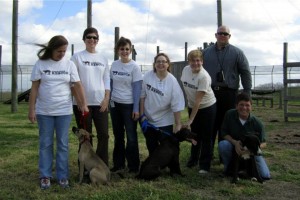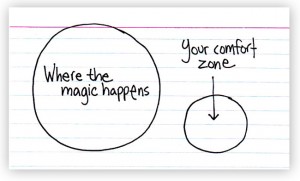Michael Baugh CPDT-KSA, CDBC
The place is about 25 minutes north of where anyone ever really goes. It’s out past where the road narrows to one lane in each direction. It’s where the houses are more spread out, too far out to be the suburbs, not quite far enough to be out-in-the-country. It’s an easy drive, and easy to find too. Just head north and hang a hard left outside my comfort zone.
When I was 5 or 6 years old I asked my dad when I’d have to go to jail. My older sister was dating a drug dealer at the time and he’d been sent off. I figured that everyone went to jail sometime because that’s what happened to Ricky, “the pusher” my parents called him. My dad assured me I didn’t have to go to jail, and that no one in our family had ever been there either. Ricky was different, not like us. Maybe so, I don’t’ know. I never did go to jail as it turns out. I didn’t even have to go to a public school.
I could lie and say the place looks like a high school. Sure enough there were teenage boys playing basket ball out back, lanky and laughing. But the court was in a big yard surrounded by a big fence with wire on top. This was jail, jail for kids. It has a nicer name than just that, and the good people who work here are focused on helping the kids make things right. Still, the boys can’t just leave at the end of the day. They’re locked in. There’s some hard truth to that fact and it’s not easy to forget.
The doors buzz open, and lock, and echo hollow despair just like real jail doors. I sign in and they run a magnetic wand over me just to be sure I’m not brining in anything metal, anything that could be a weapon. I’m not. It’s just a car key, and my driver’s license. They walk me down a wide hall, government sparse and clean, to a room near the end on the left side, another left just a bit further than I’d ever gone before.
This is my dog training class for the next 8 weeks. There are 6 boys whose names I’m not allowed to share. They are 17 and younger, brown skinned every one, polite, engaging, relaxed. We’re in a large space that could be the common room in any university dorm building. On the left wall are three large dog crates. I met the dogs a week before I met the boys and I can share their names: Oreo, Skipper, and Tara. They are all under a year, black or brown coated, friendly, and fast asleep.
The dogs, every one, came from a part of town called The Corridor of Cruelty. It’s the kind of place you don’t ever go to if you grew up in North Dallas and were afraid even of public school. It’s like where my mom confronted the pusher’s parents, where the police came to get Ricky, to take him to jail. Police come to these places a lot. And guys who fight dogs on the weekends for fun, even if not for money, dump their old stock here, rejects and bait dogs. The dogs wander and starve. They have their puppies and whither in the heat or shiver in the cold. The place has bones bleached white, carcasses of dogs gone dead before anyone cared or could even think of caring. This is where my three students came from, the dogs. I don’t know where the boys came from. I couldn’t say even if I did know.
Women save the dogs. That’s the way it is mostly. It started with just one who gathered the others and formed a group to help the dogs in the Corridor. They named themselves after the place long after they started feeding dogs, luring them into cars and putting them in foster homes. The dogs are just dogs mostly, mixes of this and that, genetics unknown. Some look like pit bulls, but very few are fighters. That’s probably why they ended up here. Fighting dogs don’t get dumped.
There are two boys for every dog in the dorm on the left side of the long hall. Adolescent dogs with adolescent boys, I don’t know if it’s love but they’re attached to each other already. How does that happen so fast?

Team Oreo are two black 16 year old kids. One of them plays basketball. When I was explaining how we make learning easy for the dogs and increase difficulty gradually, he told me he could play four quarters of a game straight through now but when he was first starting he could only play one or two. That’s exactly the way it is, I said. His training partner doesn’t talk much, if at all. Oreo is a black and white pit mix, 7 or 8 months old. He play bites. Attention slips away from him quickly, but he’s sharp and fast. He’s the first to nail a left finish with his own added style. He comes when called but struggles with stay. He’s perfectly matched to his boys in those regards.
Team Tara is lead by a fiercely intelligent 17 year old African American boy with freckles and reddish hair. He likes math, loves numbers he says. He makes eye contact and shakes hands and asks more questions than the others. Why are you here? I want to ask, but I decided going into this that I wouldn’t ask, not any of them. Like in team Oreo, the other boy is younger and quieter. Tara herself is the only female, brown and blocky. She’s the one who looks most like a pit bull, but not all the way. She and Oreo have bonded and play with abandon. Still, when she is working she’s intense and serious. Just like her boys.
Team Skipper are two Latin boys who appear to be good friends, more so than the other teams. They share responsibilities equally and sometimes laugh and joke. But other times the shorter one wanders off without ever taking a step, staring down at the grass, leaving us while he stands there, traveling far beyond the fence and down the road and into the city. Then, just as suddenly as that, he returns. Skipper is the youngest dog. He still has some of his juvenile teeth. When it’s time to line up and take the dogs outside, he’s brought out of his crate last because he can’ t hold his bladder. Skipper is a quiet cooperative dog. He’s the only one to walk on a regular leash and collar (the others use Gentle Leader Head Collars).
In so many ways this class is like all the others. The boys are learning the mechanical and timing skills of dog training. They’re learning not to repeat cues, and how to be patient with their impulsive young dogs. But, this class is different too. The stakes are high, higher for these boys than it is even for the dogs in their care. They are focused and responsive and engaged at a level much greater than any of my other clients. Raising and training these dogs matters to them. I won’t presume to know why. It may be that everything matters here, every skill, every lesson, every bond. If something goes wrong again they won’t come back here. It won’t be jail for kids. It will just be jail. The stakes are high.
 I saw a picture on facebook today. It showed a big hand draw circle with the label “where the magic happens.” Then there was a smaller separate circle off to the right: “Your comfort zone.” I wonder. Am I where the magic happens? More dogs die in the Corridor of cruelty every year than come out. Oreo, Tara and Skipper are the exceptions. And what about these boys? What about all these boys, in the other dorms, or on the outside in the city trapped in their own private prisons? What about the ones who go quiet, who stare down at the grass and wander away in their minds to who-knows-where, escaping who-knows-what?
I saw a picture on facebook today. It showed a big hand draw circle with the label “where the magic happens.” Then there was a smaller separate circle off to the right: “Your comfort zone.” I wonder. Am I where the magic happens? More dogs die in the Corridor of cruelty every year than come out. Oreo, Tara and Skipper are the exceptions. And what about these boys? What about all these boys, in the other dorms, or on the outside in the city trapped in their own private prisons? What about the ones who go quiet, who stare down at the grass and wander away in their minds to who-knows-where, escaping who-knows-what?
I always push on the door just before the buzzer unlocks it. I’ve always been awkward like that, a bit too anxious to leave, a bit nervous about being locked in. When do I go to jail, Dad? When do I get out? I settle into my car, tired from teaching and dirty from jumping dogs. I stare up at the deep blue winter sky and then at the high school that’s really not. This has to be where the magic happens. I believe in magic, and it has to be here.
